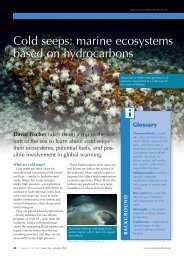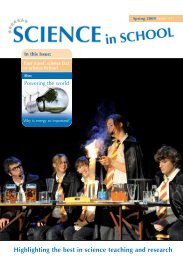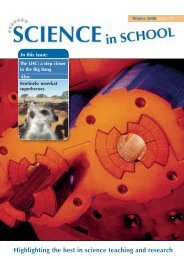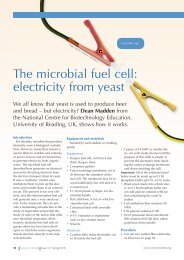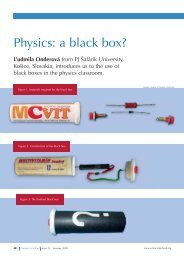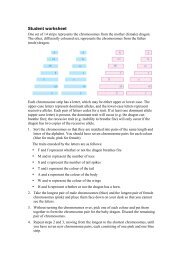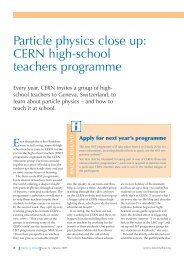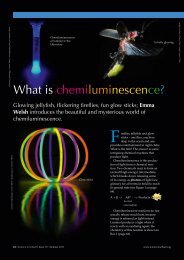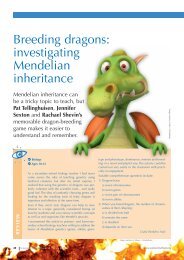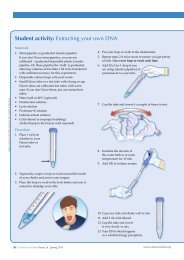Download Issue 14 as PDF [5.4 MB] - Science in School
Download Issue 14 as PDF [5.4 MB] - Science in School
Download Issue 14 as PDF [5.4 MB] - Science in School
You also want an ePaper? Increase the reach of your titles
YUMPU automatically turns print PDFs into web optimized ePapers that Google loves.
Teach<strong>in</strong>g activities<br />
example, by medical physicists to<br />
detect tumours and monitor the function<br />
of <strong>in</strong>ternal organs.<br />
Here we demonstrate how to br<strong>in</strong>g<br />
particle physics to life <strong>in</strong> the cl<strong>as</strong>sroom,<br />
us<strong>in</strong>g possibly the simplest<br />
type of particle detector: a cont<strong>in</strong>uously<br />
sensitive diffusion cloud chamber.<br />
This homemade version consists<br />
simply of an airtight fish tank full of<br />
air and alcohol vapour, cooled to a<br />
very low temperature, which can be<br />
used to detect charged particles, particularly<br />
cosmic ray muons, if they<br />
have enough energy.<br />
Elementary particles<br />
Elementary particles are the simplest<br />
elements from which everyth<strong>in</strong>g<br />
is made. They are not just the build<strong>in</strong>g<br />
blocks of matter and radiation,<br />
but also give rise to the <strong>in</strong>teractions<br />
between them (for more details of elementary<br />
particles, see Landua & Rau,<br />
2008). These particles carry energy<br />
and momentum, and can thus be seen<br />
by detectors. Strictly speak<strong>in</strong>g, you<br />
cannot directly see any particles –<br />
<strong>in</strong>stead, their p<strong>as</strong>sage through detectors<br />
is <strong>in</strong>ferred from the effects they<br />
cause, such <strong>as</strong> ionisation (for charged<br />
particles). That is precisely what we<br />
do when we observe the condensation<br />
trail left <strong>in</strong> the sky by an aeroplane that<br />
we cannot see – and what we can do<br />
with our homemade cloud chamber.<br />
The cont<strong>in</strong>uously sensitive<br />
diffusion cloud chamber<br />
This cloud chamber is b<strong>as</strong>ically an<br />
airtight conta<strong>in</strong>er filled with a mixed<br />
atmosphere of air and alcohol vapour.<br />
Liquid alcohol evaporates from a<br />
reservoir and diffuses through the air<br />
from the top to the bottom of the<br />
chamber. Cool<strong>in</strong>g the b<strong>as</strong>e with dry<br />
ice (solid carbon dioxide, which is at a<br />
constant temperature of around -79 ºC<br />
while it sublimates) results <strong>in</strong> a strong<br />
vertical temperature gradient, so that<br />
a zone with supersaturated alcohol<br />
vapour forms close to the bottom.<br />
This sensitive layer is unstable, with<br />
more very cold alcohol vapour than it<br />
can hold. The process of condensation<br />
of vapour <strong>in</strong>to liquid can be triggered<br />
by the p<strong>as</strong>sage of a charged particle<br />
with enough energy to ionise atoms<br />
<strong>in</strong> its path. These ions are the condensation<br />
nuclei around which liquid<br />
droplets form to make a trail.<br />
Assembly and operation<br />
Materials<br />
· Straight-sided, clear pl<strong>as</strong>tic or gl<strong>as</strong>s<br />
conta<strong>in</strong>er (e.g. a fish tank) with a<br />
b<strong>as</strong>e about 30 cm x 20 cm, and a<br />
height around 20 cm (other sizes<br />
can be used, but the effects may<br />
vary)<br />
· Alum<strong>in</strong>ium sheet (about 1 mm<br />
thick, same thickness <strong>as</strong> the b<strong>as</strong>e<br />
of the fish tank)<br />
· Shallow tray somewhat larger than<br />
the b<strong>as</strong>e area of the fish tank<br />
Two lamps, one of them strong<br />
· Strip of felt (about 3 cm wide and<br />
long enough to wrap around the<br />
<strong>in</strong>side of the fish tank, e.g. somewhat<br />
more than 1 m long)<br />
Glue (not alcohol-soluble)<br />
Black <strong>in</strong>sulat<strong>in</strong>g tape or duct tape<br />
Isopropyl alcohol (isopropanol)<br />
· Dry ice<br />
REvIEW<br />
Particle Physics<br />
alcohol reservoir<br />
track<br />
Outl<strong>in</strong>e of a cont<strong>in</strong>uously sensitive<br />
diffusion cloud chamber<br />
conta<strong>in</strong>er<br />
charged particle<br />
tape<br />
diffusion<br />
sensitive layer<br />
dry ice at -80 ºC<br />
alum<strong>in</strong>ium plate<br />
Fold tape and stick<br />
to the bottom<br />
Cross-section of the cloud chamber<br />
Cosmic rays consist of subatomic particles that come from space<br />
and strike Earth’s atmosphere, creat<strong>in</strong>g a shower of secondary particles<br />
that can be studied at the Earth’s surface. Students <strong>in</strong> secondary<br />
education can usually only read about those particles <strong>in</strong> books<br />
or study them through simulations – although the particles constantly<br />
p<strong>as</strong>s through our bodies.<br />
Here, Francisco Barrad<strong>as</strong>-Sol<strong>as</strong> and Paloma Alameda-Meléndez<br />
present the idea that cloud chambers can be used by students <strong>as</strong> an<br />
experimental tool, enabl<strong>in</strong>g them to conduct their own <strong>in</strong>vestigations<br />
on radiation. They also provide details about the construction<br />
of a cloud chamber, equipment that can be built at school without<br />
too much difficulty, which enables students to observe these subatomic<br />
particles <strong>in</strong> the cl<strong>as</strong>sroom by mak<strong>in</strong>g their tracks visible.<br />
Vangelis Koltsakis, Greece<br />
Images courtesy of Francisco Barrad<strong>as</strong> Sol<strong>as</strong><br />
www.science<strong>in</strong>school.org <strong>Science</strong> <strong>in</strong> <strong>School</strong> <strong>Issue</strong> <strong>14</strong> : Spr<strong>in</strong>g 2010 37


![Download Issue 14 as PDF [5.4 MB] - Science in School](https://img.yumpu.com/26126440/39/500x640/download-issue-14-as-pdf-54-mb-science-in-school.jpg)


